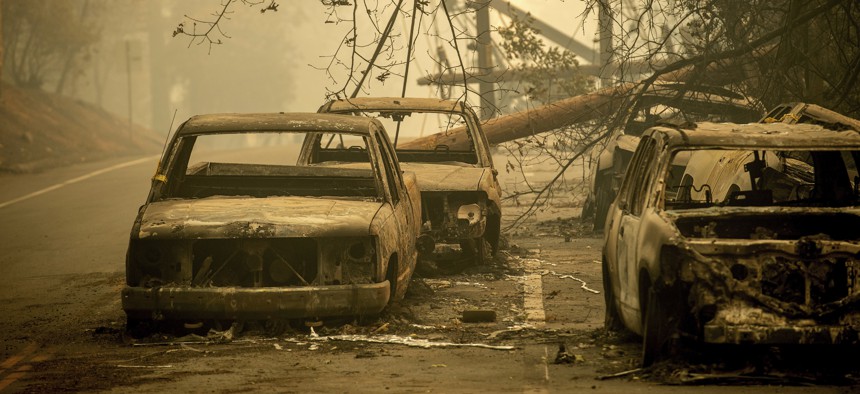When a Deadly Disaster Is 15 Minutes Away Or Less

Abandoned cars, scorched by the wildfire, line Pearson Rd. in Paradise, Calif., on Saturday, Nov. 10, 2018. Noah Berger / AP Photo
The Camp Fire’s conflagration prompts important what-if questions for many communities that have limited evacuation routes.
The Camp Fire still being battled to containment in the Sierra Nevada foothills north of Sacramento, California is the type of disaster that prompts questions in communities with limited evacuation routes that are vulnerable to wildfires, flash floods and other threats that can rapidly turn deadly: What would happen if you had to evacuate thousands of people very quickly?
It’s been a very real and difficult question in Butte County, where the Camp Fire, the state’s deadliest and most destructive wildfire on record, has been burning since last week.
At least 63 people died last Thursday in and around the town of Paradise, where many were caught off guard by the Camp Fire’s quickly moving flames. With many more people unaccounted for, authorities fear the death toll will rise. As search teams go through the town’s charred ashes and family members submit DNA samples to help identify remains, Paradise’s chaotic evacuation has come under scrutiny.
As the wind-driven flames approached town from the northeast, authorities only issued limited evacuation orders at first. Hoping to avoid a repeat of a chaotic wildfire evacuation from 2008, where the four roads leading out of Paradise were clogged with the cars of fleeing residents, authorities first evacuated neighborhoods closest to the advancing flames.
The problem, as the Los Angeles Times reported this week, was that “it soon became clear that the fire was moving too fast for that plan, and that the whole town was in jeopardy. A full-scale evacuation order was issued at 9:17 a.m., but by then the fire was already consuming the town.”
That’s where residents in Paradise had to make quick and often very brave decisions in how to reach safety, like the heroic nurses evacuating the Feather River Hospital driving through flames to save patients.
As the Camp Fire’s death toll and the list of unaccounted shows, it was already too late for many trying to drive out of town when their cars were consumed by the conflagration.
"Well people died, yes. It did not go perfectly," Mayor Jody Jones said of the evacuation after an emotional town meeting in nearby Chico on Tuesday night, according to KPIX. "I don't know that we could have had a plan that was better, though. The reason we couldn't get everyone out is because you can't fit 26,000 people on the roads all at the same time."
There are countless other communities like Paradise across western states where limited ways in and out of town, topography, fire weather conditions and a simple spark can lead to deadly and destructive results.
As fires were burning elsewhere in the state, emergency managers in San Diego County recently reminded residents to be prepared and think about what they’d do if they were told to evacuate their homes in 15 minutes.
And it’s not just wildfires that pose risks and force people to think about that 15-minute question. Last near, not too far from Paradise, Butte County had to quickly evacuate nearly 200,000 people downriver from the Oroville Dam, where there were fears that the emergency spillway could suddenly fail.
Flash flooding in communities built in isolated canyons or valleys can be deadly for similar reasons since the road to safety can also be a potential death trap.
In tsunami hazard zones, like the ones along the coasts of Oregon and Washington state, emergency managers expect that following the next megaquake along the Cascadia Subduction Zone, the first tsunami waves will start hitting the coast in about 15 minutes.
An Oregon Department of Geology and Mineral Industries study of at-risk coastal communities determined the minimum walking times to safe spots out of the inundation zone and developed “Beat the Wave” maps that “depict the minimum evacuation speed required to stay ahead of the tsunami wave given a variety of scenarios that will increase evacuation difficulty.”

This map models scenarios for Winchester Bay, Oregon, including one that assumes the earthquake’s shaking will have destroyed the Salmon Harbor Bridge, cutting off an important route to safety. In that case, anyone at the Salmon Harbor Marina will have to “sprint” to reach safety before the waves arrive. If the bridge survived intact, people will only have to “jog” or move at the pace of a “fast walk” to reach safety before the tsunami’s inundation.
That emergency management scenario is indeed grim, but as Paradise’s experience with the Camp Fire shows, it’s the type of what-if situation that at-risk communities need to be planning for.
This post was updated Thursday evening with a revised death toll.
Michael Grass is Executive Editor of Route Fifty and is based in Seattle.
NEXT STORY: Polio-like Illness AFM Tests an Overstretched Public Health System






